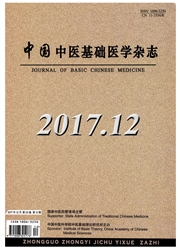

 中文摘要:
中文摘要:
目的:考察“半蒌贝及攻乌”反药组合对制川乌镇痛效果的影响并探索相关机制。方法:基于甲醛足底皮下注射致痛模型,检测致痛小鼠给药后2个时相的舔足时间,明确制川乌和法半夏、栝楼、川贝母、浙贝母、白及各单药及1∶1、1∶2和1∶3配伍组合的镇痛效果,并通过联用κ阿片受体激动剂U-69593或拮抗剂Nor-BNI以及ELISA检测致炎足NO、PGE2和TNF-α含量方法,进一步分析相关作用机制。结果:制川乌单用能明显缩短致痛小鼠2个时相的舔足时间,配伍法半夏、栝楼、浙贝母和白及后此作用减弱,呈量效关系。制川乌联用Nor-BNI后可使舔足时间延长至不给药的状态;联用U-69593后舔足时间比之前缩短,再配伍法半夏、白及后舔足时间明显延长;制川乌单用能明显降低甲醛致痛小鼠炎症足中NO、PGE2和TNF-α的含量,配伍法半夏、栝楼、浙贝母和白及后相关因子含量升高。结论:降低乌头的镇痛功效可能是“半蒌贝及攻乌”反药组合相反的具体表现之一,其机制与干扰κ阿片受体活化及增高炎症局部促炎介质含量有关。
 英文摘要:
英文摘要:
Objective: To investigate the analgesic effect and mechanism of the combined administration of Aconiti Radix Cocta with Rhizoma pinelliae, Fructus trichosanthis, Bulbus fritillariae thunbergli or Bletilla striata in formalin- induced pain mice. Methods: Formalin was subcutaneously injected into the plantar surface of ICR mice to induce a model with two phases of nociceptive licking responsiveness. The analgesic effects of the different combined administration of traditional Chinese medicine (TCM) and Aconiti Radix Cocta were observed. Then the analgesic effects of the combination of antagonist Nor-BNI or K-opioid receptor agonist U-69593 with Aconiti Radix Cocta in Formalin-induced pain mice were investigated, and the levels of NO, PGE2 and TNF-α in injured skin tissue were detected by ELISA. Results: Compared with Aconiti Radix Cocta-treated group, the combined administration of Aconiti Radix Cocta with Rhizoma pinelliae, Fructus trichosanthis, Bulbus fritillariae thunbergli or Bletilla striata increased the licking time of two phases in formalin-induced pain mice, with peak at the rate of 1: 3. Nor-BNI could reduce the analgesic effect of Aconiti Radix Cocta. The combination of Aconiti Radix Cocta and Rhizoma pinelliae or Bletilla striata could partly reduce the analgesic effect of U-69593. Furthermore, Aconiti Radix Cocta could significantly reduce levels of NO, PGE2 and TNF-α in the skin of inflamed paw, while this effects were significantly decreased when the co-administration with Aconiti Radix Cocta and Rhizoma pinelliae, Fructus trichosanthis, Bulbus fritiUariae thunbergli or Bletilla striata. Conclusion: The analgesic effect of Aconiti Radix Cocta was decreased markedly when the co-administration with Aconiti Radix Cocta and Rhizoma pinelliae, Fructus trichosanthis, Bulbus fritillariae thunbergli or Bletilla striata. It may be related to the antagonistic action of K opioid receptor and the decreased anti-inflammatory effect of Aconiti Radix Cocta on NO, PGE2 and TNF-α. This study provide
 同期刊论文项目
同期刊论文项目
 同项目期刊论文
同项目期刊论文
 A systems biology-based investigation into the pharmacological mechanisms of Wu Tou Tang(乌头汤) acting
A systems biology-based investigation into the pharmacological mechanisms of Wu Tou Tang(乌头汤) acting A systems biology-based investigation into the pharmacological mechanisms of Wu Tou Tang acting on r
A systems biology-based investigation into the pharmacological mechanisms of Wu Tou Tang acting on r 期刊信息
期刊信息
